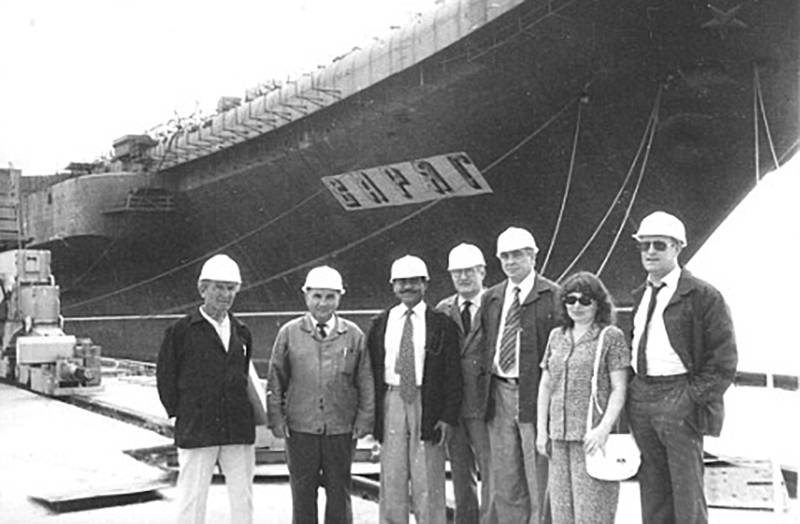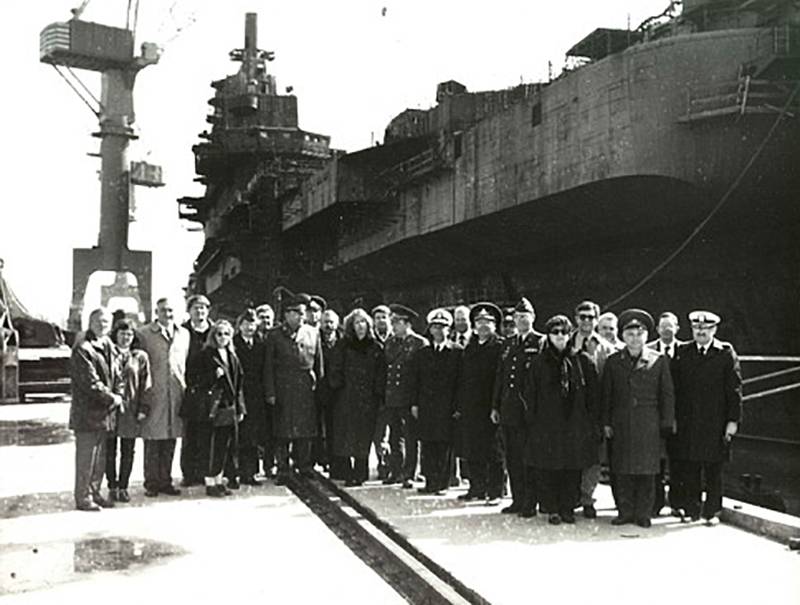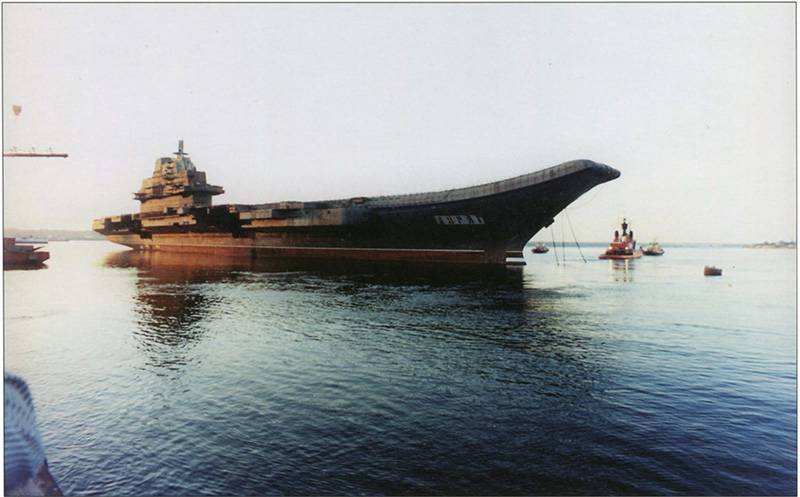Chernomorsky Shipyard: TAKR "Varyag". Preservation and sale

Bidding and bidding
Waiting for bitter moments
Above the river you rise -
Ship creativity genius,
Black ghost winged dreams.
Vyacheslav Kachurin
The management of the company, in order to cause a public outcry, tried to raise the problem of the cruiser in the media. In December 1994, the topic "Varyag" and the other unfinished ships was devoted to Listyev’s most popular program, Rush Hour. However, these efforts were in vain. In March, 1995 Russia officially announced that it was refusing to finance the construction of a cruiser. Official circles in Moscow finally lost interest in the unfinished ship, focusing on internal problems.
For a while, Ukraine was completely puzzled about what to do with an unfinished ship, whose readiness was 67%. Just cutting it for scrap was reckless, even for 90's reformers. Several options were considered, up to the conversion of the Varyag into a floating space center. However, all ideas, both realistic and not very tightly hanging in the turbulent atmosphere of that period stories.
In the end, not finding anything better, the Ukrainian government graciously declared “Varyag” the property of the plant. Translated from the official language into a human, this meant: "Now it’s your problem, what to do with such a big piece of iron." The airborne cruiser with its entire many thousands of masses leaned on the factory's shoulders already weakening from market relations. Of course, this soon affected the safety of the ship.
The fact is that the first time after the construction was stopped, Varyag was reliably guarded: not only external guard posts, but also internal posts were put up. They prevented unauthorized access to the premises with secret and valuable equipment. When the maintenance of the ship was completely transferred to the grinding mill budget, the watch regime was canceled. Internal and external posts were removed - access to the ship was now prevented by such serious engineering obstacles as padlocks with seals.
However, such sophisticated and, most importantly, "reliable" means of protection could not stop the multiplying illusionists and other nuggets - colleagues of David Copperfield, who managed to get to the "Varyag" through locked locks and lattices. The first traces of such creative personalities became, according to the memoirs of Aleksei Ivanovich Seredin, the main builder of Varyag, the looting of the Ladoga anti-aircraft missile stabilization device. Several kilograms of precious metals, including gold and platinum, were stolen. Of course, the guilty were not found. Then the process of incarnation began to grow in breadth: instruments, equipment, cables and light bulbs began to disappear from the ship.
The Black Sea Plant, like many enterprises throughout the former Soviet Union, was already experiencing severe wage arrears — reductions and layoffs began. The state did not need a ship, the plant could not maintain it. Sadly it was stated, there was only one way out - the sale of the cruiser.

Interest in “Varangian” has been manifested for a long time among various companies, primarily involved in the sale of scrap metal. A pilgrimage of practical, polite and smiling managers with tenacious views began at the Black Sea Plant. According to the memoirs of Hero of Socialist Labor Ivan Iosifovich Vinnik, the guests from South Korea were among the first to come to the plant. It is worth noting that businessmen from this country already had sufficient experience in the purchase of withdrawn from the Pacific fleet heavy aircraft cruisers: "Minsk" and a little later, "Novorossiysk". Now, close to the wall of the Black Sea Varyag plant, the closest attention of business circles selling scrap metal has come into the picture.
The gentlemen from South Korea, of course, were far from alone in their desire to get the hull of a huge unfinished ship. Visitors to the plant were frequent - only about 60 of potential buyers were recorded. The subject of interest was a steel bulk of an unpainted body near the wall of the CSY. 32 is thousands of tons of metal, of which 18 thousands were in the hull, and the rest was the main turbo gear units, boilers, pumps and a large number of other mechanisms, equipment and other goodies.
The price of scrap metal on the world market at that time was 127 dollars. Consequently, the total amount that could be rescued for Varyag in the form of a floating scrap metal warehouse was equal to 4 with a small million US dollars. By the way, the US delegation, consisting of guests in military uniforms and those who keep uniforms in their closet due to the nature of the service, also visited the Black Sea factory and examined the unfinished ship of a recently probable enemy. It seems that the composition of a slowly but inevitably dying huge factory, where in some places lay piles of ship steel of the cut Ulyanovsk with a mass of doom-rusting Varyag, lay still, the overseas guests liked.

The cruiser, of course, could be sold quickly at the price of scrap metal, but other options were also considered. Not all foreign clients saw in Varyag only a candidate for a break. There were other projects and proposals, often quite extravagant. Several times the representatives of the fairly well-known French brokerage firm Barry Rogliano Salles headed by businessman Jean-Martin Hunderi visited the Black Sea Plant. The entrepreneur was carrying the idea of re-equipping the Varyag into a shocking cruise ship, where during the flight the flights of the planes would be shown to passengers - a peculiar hybrid of a liner and a floating mobile air show. With a more detailed acquaintance with the unfinished cruiser, the French abandoned their ambitious project. The height of the interior on the Varyag did not exceed 2200 mm, which was an incompatible parameter with the standard norms of cruise liners. The volume of internal alterations would be too large.
Other potential buyers saw the ship as a hull for refitting it into a luxury hotel or a no less respectable floating casino. Representatives of Great Britain wanted to buy Varyag in order to turn it into a prison. However, the appetites of buyers, like their fantasies, each time inexorably cooled the fact of the cruiser’s large and expensive rework into something nonmilitary and profitable. But the Varyag was originally designed and built precisely as a warship with all the requirements and norms arising from this mission.
Sale of an unfinished ship was delayed. Finally, an agreement was reached with an Irish company that offered 240 US dollars per ton. It was almost twice the standard price for scrap metal, and as a result, about 8 million could be earned for Varyag. The then director of the Black Sea Shipbuilding Plant, Igor Nikolayevich Ovdienko, who took this position instead of Yuri Makarov, who left because of his health reasons, signed a contract.
However, Kiev intervened in the implementation of this contract. Pavel Lazarenko, who was appointed to the post of prime minister, with his power annulled the already signed agreement. It is likely that he had good reasons for this. A tender for the sale of Varyag was officially announced. In 1998, it was won by the Chinese company Chong Lot Travel Agency Ltd, registered in Macau. She offered 20 million dollars for the Varyag, declaring that she would convert the cruiser into a floating entertainment center.
By this time, Chinese businessmen had already purchased two heavy aircraft-carrying cruisers, Kiev and Minsk, for the same purpose. There are still a lot of white spots in this story. Suffice it to say that the firm that acquired the unfinished cruiser turned out to be a dummy stock with tiny capital. The People's Republic of China received a signal from Ukraine back in 1992 that the latter did not mind selling the Varyag inherited from the USSR.
There were still verbose discussions between Moscow and Kiev on the subject of who, like and for whose funds would finish building the aircraft-carrying cruiser, but the most pragmatic politicians understood that all this is nothing more than useless air shaking. Completed and combat-ready "Varyag" would be sold more readily than the unfinished one - a different price could be requested for it.
The Black Sea Plant was visited by a special delegation of representatives of the People’s Liberation Army of China, headed by Major General Zheng Min, who was at that time the head of the weapons department of the PLA Navy. The Chinese military inspected the ship and were more than satisfied with what they saw. Returning to China, Zheng Ming strongly recommended his leadership to make the purchase of "Varyag".
However, political circumstances were formed at that time in a different pattern. The memory of the events on Tiananmen Square was still fresh, the Soviet Union collapsed, and the balance of forces on the world stage has changed significantly. Head of State Jiang Zemin directed the vector of China’s foreign policy towards improving relations with the United States. The appearance of an aircraft carrier in the Chinese fleet could once again cause some dissatisfaction and even irritation of the western "partners", so the decision to acquire the "Varyag" was then postponed, waiting for a more convenient situation.
The cruiser for several years stood at the wall of the Black Sea Plant in anticipation of its still not a certain fate. Cases with its sale, despite some excitement with customers, stubbornly moved from the spot. And in Kiev, and then in Nikolaev, Mr. Xu Zeng Ping and his team appeared. The Chinese have offered a price of 20 million dollars for the future "entertainment center" and in the end turned out to be the winners.
In his interviews, the former captain of the army basketball team, and later a businessman specializing in organizing mass events with commercial gain, said that he was making his way to concluding a contract for the purchase of Varyag with packs of dollars and vodka boxes, filling bottomless alcohol-containing liquids, as he claimed, the holds of the representatives of the factory administration.
However, according to the memoirs of the Hero of Socialist Labor, Ivan Iosifovich Vinnik, at that time deputy director for production, all this is not true.
The matter was finally done, and the parties shook hands. But the procedure for selling such a large object as an aircraft carrying cruiser was somewhat more complicated and longer than it seemed. After all, the object of the transaction was a huge ship, saturated with various equipment, by the time the agreement was signed, partly already mysteriously disappeared. A routine bureaucratic red tape, usual in such situations, began.
Ivan Iosifovich Vinnik, deputy director for production, didn’t get out of Kiev for almost a year and a half. 22 approval and approval of ministries and organizations was required - the ship was still considered secret in many ways. Satisfied with the deal, Xu Zeng Ping left for China, or rather Macau, which formally was a Portuguese colony that existed in recent months. A representative of the Chinese company Yan Sun Xin remained at the plant, who looked after the ship and monitored the situation. As it turned out later, the true workplace of this gentleman, although it assumed foreign travel, however, had nothing to do with the tourism and entertainment business.
While the flywheels of the bureaucratic machine were spinning, the Varyag continued to stand at the wall of the Black Sea plant, whose economic situation was deteriorating more and more. There were no orders, wage arrears increased. Signing a contract with a company from Macau turned out to be a very good help - the Chinese side paid for the Varyag parking in the factory at the price of 5 thousand dollars daily. Thus, about 150 thousand per month. These revenues allowed the company, which in Soviet times produced products in the tens of millions of rubles, to somehow make ends meet.
Chinese designers even visited the cruiser, estimating details and features of the future interior as a floating entertainment center. At the beginning of 2000, the buyer expressed a desire to carry out the completion and re-equipment of the Varyag directly at the Black Sea plant. The contract value was estimated at 200 – 300 million dollars. However, the Chinese side discussed this issue without much enthusiasm and perseverance. As it turned out, she had other plans for this.
In the spring of 2000, it became known that Varyag will be towed to China, where its transformation into an entertainment center will take place. The Suhaili ocean rescue tugboat assigned to Panama arrived at the Black Sea Plant. His team consisted mainly of Filipinos. At the stern "Varyag" at the request of the customer was inscribed "Kingstown" - supposedly the port of registry.

Early in the morning of June 14, the Suhaili 2000 and factory tugs tore off the heavy Varyag aircraft-carrying cruiser from the native extension wall and dragged along the Southern Bug and the estuary to the Black Sea. At the insistent request of the Chinese side, neither the press nor the television were invited to leave the ship. No special ceremony was performed. The former director of the Black Sea Plant, Yuri Ivanovich Makarov, while being treated on the Voloshskaya Spit in 15 km south of the city, went out to conduct his brainchild. In the eyes of this honored man, under whose leadership more than five hundred ships and vessels, most of the heavy aircraft-carrying cruisers, were built, there were tears. "Varyag" left the factory, and with it went a whole epoch of the history of the factory, city, fleet and the state, which was no longer there.
Behind the mists soon
And a tear dries in the wind.
There is no worse shame in the world
Than treacherously hide the eyes.
So the Nikolaev poet, the head of the Black Sea Shipyard’s literary union Vyacheslav Kachurin will write about this unhappy event in his poem “Farewell to the Varyag”. The ship itself was waiting for a dramatic odyssey ahead - a long way to the Far East.
To be continued ...
- Denis Brig
- CSY: TAKR "Varyag"
CSY: “Tbilisi” - “Admiral Kuznetsov”, completion and service of a heavy aircraft-carrying cruiser
CSV: TAKR "Riga" - "Leonid Brezhnev"
CSY: aircraft carriers and espionage
CSY: rolls of the project "Atlantic"
ChSZ: military weekdays of dry-cargo ships of the Nikolaev construction
CSY: reconstruction of the plant and the transition to large-block assembly. TAKR "Baku"
CSY: the development of heavy aircraft-carrying cruisers. "Minsk" and "Novorossiysk"
CSY: TAKR "Kiev"
CSY: research vessel "Akademik Sergey Korolev"
CSY: whalers and anti-submarine cruisers
Information